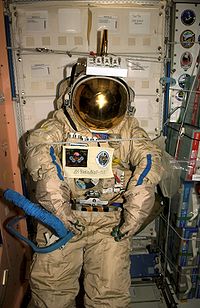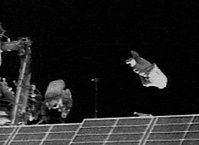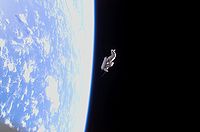
SuitSat
Encyclopedia



SuitSat is a retired Russian Orlan spacesuit
Orlan space suits
thumb|right|270px|Cosmonaut [[Maksim Surayev]] next to two Orlan-MK modelsAn Orlan space suit |sea eagle]]) is a series of semi-rigid one-piece space suit models designed and built by NPP Zvezda. They have been used for spacewalks in the Russian space program, the successor to the Soviet space...
with a radio transmitter mounted on its helmet. SuitSat-1 was deployed in an ephemeral
Ephemeral
Ephemeral things are transitory, existing only briefly. Typically the term is used to describe objects found in nature, although it can describe a wide range of things....
orbit
Orbit
In physics, an orbit is the gravitationally curved path of an object around a point in space, for example the orbit of a planet around the center of a star system, such as the Solar System...
around the Earth
Earth
Earth is the third planet from the Sun, and the densest and fifth-largest of the eight planets in the Solar System. It is also the largest of the Solar System's four terrestrial planets...
on February 3, 2006. The idea for this novel OSCAR
OSCAR
OSCAR is an acronym for Orbiting Satellite Carrying Amateur Radio. OSCAR series satellites use amateur radio frequencies to facilitate communication between amateur radio stations. These satellites can be used for free by licensed amateur radio operators for voice and data communications...
satellite was first formally discussed at an AMSAT
AMSAT
AMSAT is a name for amateur radio satellite organizations worldwide, but in particular the Radio Amateur Satellite Corporation with headquarters at Silver Spring, Maryland, near Washington DC. AMSAT organizations design, build, arrange launches for, and then operate satellites carrying amateur...
symposium in October 2004, although the ARISS-Russia team is credited with coming up with the idea as a commemorative gesture for the 175th anniversary of the Moscow State Technical University.
"SuitSat is a Russian brainstorm," according to Frank Bauer of NASA's Goddard Space Flight Center. "Some of our Russian partners in the ISS program, mainly a group led by Sergey Samburov, had an idea: Maybe we can turn old spacesuits into useful satellites." SuitSat is a first test of that idea.
SuitSat-1
In a move originally planned for December 6, 2005, SuitSat-1 entered its own independent orbit just after 23:05 UTC on February 3, 2006 when it was taken on a spacewalkExtra-vehicular activity
Extra-vehicular activity is work done by an astronaut away from the Earth, and outside of a spacecraft. The term most commonly applies to an EVA made outside a craft orbiting Earth , but also applies to an EVA made on the surface of the Moon...
from the International Space Station
International Space Station
The International Space Station is a habitable, artificial satellite in low Earth orbit. The ISS follows the Salyut, Almaz, Cosmos, Skylab, and Mir space stations, as the 11th space station launched, not including the Genesis I and II prototypes...
by Valery Tokarev
Valery Tokarev
Valeri Ivanovich Tokarev , Russian Air Force Colonel and test cosmonaut at the Yuri A. Gagarin Cosmonaut Training Center, was born October 29, 1952 in the town of Kap-Yar, Astrakhan Oblast and currently resides at Star City, Moscow Region. He has traveled to space twice and has performed two career...
and Bill McArthur
William S. McArthur
William Surles McArthur, Jr. is a retired U.S. Army Colonel, a NASA astronaut, and a veteran of three space shuttle missions and one expedition to the International Space Station via the Russian Soyuz capsule.-Army career:...
as part of an unrelated spacewalk. Voice messages recorded by the teams involved, and by students from around the globe, were continuously broadcast in a number of languages from the SuitSat, along with telemetry data. The signal began transmission approximately 15 minutes after SuitSat-1 was jettisoned and was relayed by equipment onboard the ISS. Anyone receiving the transmission could log an entry on the tracker at suitsat.org, detailing when and where they heard it.
However, the SuitSat-1 mission was not a total success. There were very few reports that actually confirmed the receiving of the transmission. NASA TV
NASA TV
NASA TV is the television service of the United States government agency NASA. NASA TV is broadcast by satellite with a simulcast over the Internet. Local cable television systems across the U.S. and amateur television repeaters may carry NASA TV at their discretion, as NASA-created content is...
later announced that SuitSat ceased functioning after only two orbits due to battery failure, but there were reports suggesting that SuitSat-1 continued transmitting, though far weaker than expected.
The official designation for SuitSat is AMSAT-OSCAR 54, though it was nicknamed "Ivan Ivanovich
Ivan Ivanovich
Ivan Ivanovich, the Russian equivalent for 'John Doe' was the name given to a mannequin used in testing the Russian Vostok spacecraft in preparation for its manned missions....
" or "Mr. Smith
Mister Smith
Mister Smith is a placeholder name for a generic person .It can also mean:* Mr. Smith , a hiphop album by rapper LL Cool J* Mr. Smith , a novel by Louis Bromfield...
". The radio transmitter used a frequency of 145.990 MHz.
The last confirmed signal report from SuitSat-1 was the report of KC7GZC on February 18, 2006, all later reports indicate that no signal was received when SuitSat-1 was due to pass over.
On September 7, 2006, at 16:00 GMT, Suitsat re-entered the Earth's atmosphere
over the Southern Ocean at 110.4° East latitude and 46.3°South longitude. It was over a
point some 1400 km south-southwest of Cape Leeuwin (Augusta), Western Australia.
ARISSat-1 (formerly SuitSat-2)
ARISSat-1, another ISS hand launched satellite, is currently in development. This satellite will contain experiments built by students and a software defined radio capable of supporting a U/v linear transponder, FM telemetry, voice recordings and live SSTV imagery. Unlike SuitSat-1, the batteries on ARISSat-1 will be charged by solar panels, and is predicted to have a lifetime up to six months (when it is expected to deorbit).External links
- AMSAT satellite detail
- suitsat.org
- Russian site about SuitSat satellite series
- SuitSat Audio Recordings and Updates - AJ3U.com
- NASA press release: "SuitSat: Using a simple police scanner or ham radio, you can listen to a disembodied spacesuit circling Earth."
- NASA Releases SuitSat 1 includes video and technical details
- "SuitSat-2 Now Called ARISSat-1"

